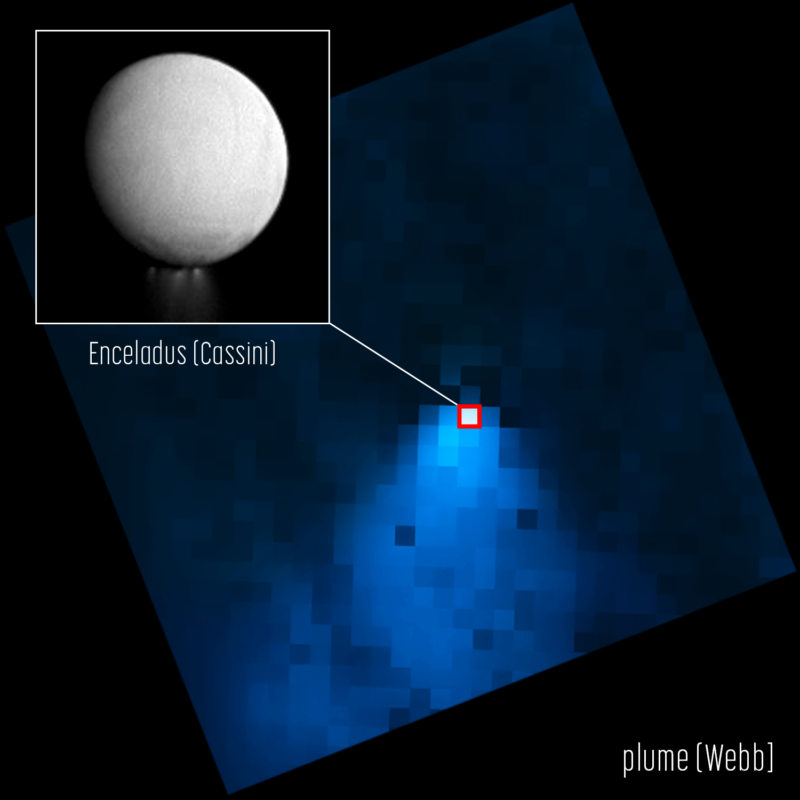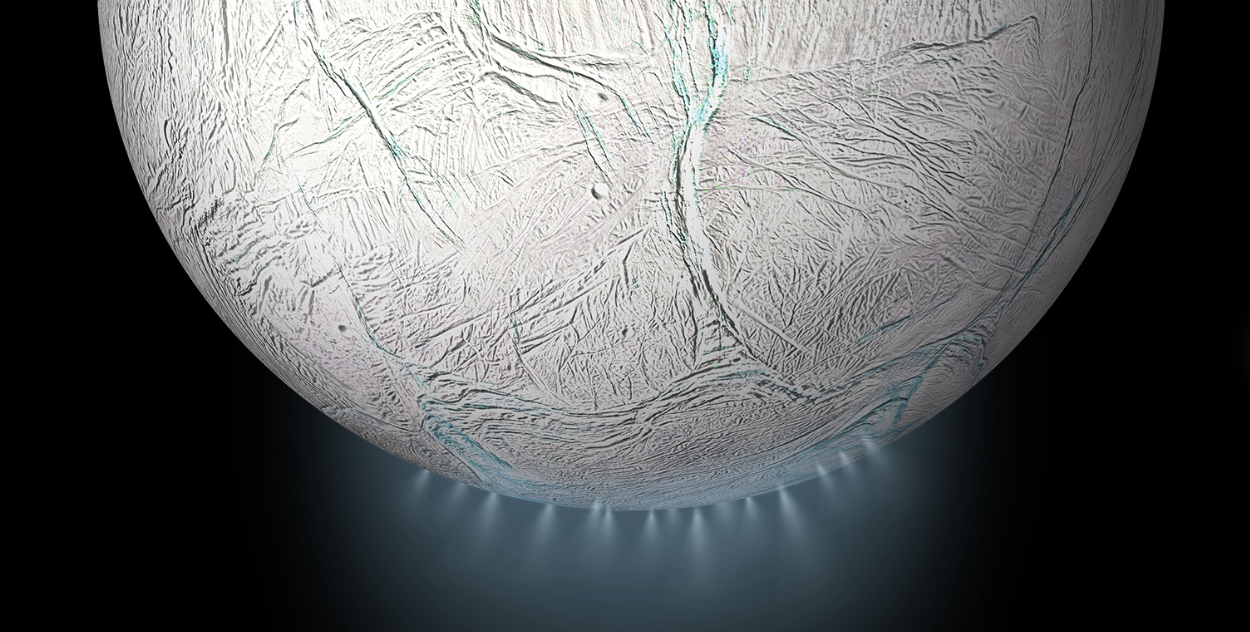
Enceladus, a frozen moon orbiting Saturn, has caught the interest of scientists because of the plumes of water vapor that erupt from its icy crust, which are possible evidence for a subsurface ocean. And an ocean means it has the potential for life (at least life as we know it). Now NASA’s James Webb Space Telescope (JWST) has caught sight of a plume like no other.
Plumes of water vapor erupt from Enceladus via cryovolcanoes that form over cracks in the ice. These plumes can extend hundreds of miles from the surface. When a team of NASA researchers looked closely at the new JWST data, they realized one plume near the moon’s south pole was far larger than any other. At over 9,500 km (6,000 miles) long, this is the most extensive spray of water ever seen in space. It is 20 times the size of Enceladus itself and extends far enough to easily cover the distance from Los Angeles to Buenos Aires. As Enceladus continued to orbit Saturn, this water vapor plume formed a ghostly halo around the planet.
“This level of [water] activity… establishes Enceladus as a prime source of water across the Saturnian system,” the researchers said in a study accepted for publication in Nature Astronomy.
Building rings
The halo (or torus) Enceladus leaves in its wake actually creates most of Saturn’s E-ring, which is its largest outermost ring. Though Enceladus was suspected to be geologically active since the Voyagers visited Saturn, NASA researchers analyzing data from the Cassini orbiter and Herschel Observatory first confirmed the existence of geysers in 2005. In 2019, further Cassini observations showed the E-Ring was largely formed by water vapor plumes gushing out of Enceladus, which explains why this ring appears fainter and hazier than the others.
Cassini’s flybys and mass spectrometer also found widespread water vapor throughout the rings of Saturn and its other moons. Webb added to Cassini’s legacy by providing a broader view of the Saturn system. It now gives unprecedented insight into how water vapor from emissions like this contributes to the torus and the overall water supply for Saturn and its rings.
Webb’s instruments were able to tell that most of the droplets of water from the vapor Enceladus regularly spews out don’t stay within the torus near the moon. Its 33-hour orbit—just 1.37 days on Earth—means that it sprays water vapor widely around Saturn. It does so especially fast, with the megaplume spraying an astounding 300 liters (79 gallons) every second. The observations Webb beamed back indicate that only about 30 percent of that water stays in the torus, while 70 percent is dispersed throughout the rest of the Saturnian system. Meaning, Enceladus supplies the system with most of its water.
What’s in the water?
Webb’s observations were done using the Integral Field Unit (IFU), which can simultaneously image an object and see the spectra it is giving off, which tells us what substances make up the object. The IFU is part of Webb’s Near-Infrared Spectrograph (NIRSpec) instrument, which can see molecular emissions across a broad range of the infrared spectrum. Infrared emissions coming from the plume revealed not only that it was made up of water vapor, but how far that water vapor extended from the surface, which revealed its immense size.
The NIRSpec data was also checked for organic molecules such as carbon monoxide, carbon dioxide, methane, ethane, and methanol, which could be possible indicators of life or prebiotic processes. There were no traces of these organics in the plume.
“As we prepare to send new spacecraft into the outer Solar System, these observations demonstrate the unique ability of JWST in providing critical support to the exploration of distant icy bodies and cryovolcanic plumes,” the researchers also said in the study.
Even though there were no organics in the megaplume, the vaporous plumes of Enceladus are thought to originate from hydrothermal vents deep in its subsurface ocean. These formations are also found on Earth’s seafloor, where hot water heated by underground magma gushes into its otherwise freezing surroundings. The core of Enceladus generates enough heat to keep water liquid.
Maybe someday, another cryovolcanic eruption captured by Webb could show evidence of life in the hidden world of its ocean. Enceladus water vapor has already been found to contain organic compounds that are capable of chemically reacting to produce amino acids, the building blocks of life on Earth, and someday, we may see more potential signs of life emerge.
Elizabeth Rayne is a creature who writes. Her work has appeared on SYFY WIRE, Space.com, Live Science, Grunge, Den of Geek, and Forbidden Futures. When not writing, she is either shapeshifting, drawing, or cosplaying as a character nobody has ever heard of. Follow her on Twitter @quothravenrayne.
Listing image by NASA, ESA, CSA, STScI, and G. Villanueva



3175x175(CURRENT).thumb.jpg.b05acc060982b36f5891ba728e6d953c.jpg)
Recommended Comments
There are no comments to display.
Join the conversation
You can post now and register later. If you have an account, sign in now to post with your account.
Note: Your post will require moderator approval before it will be visible.